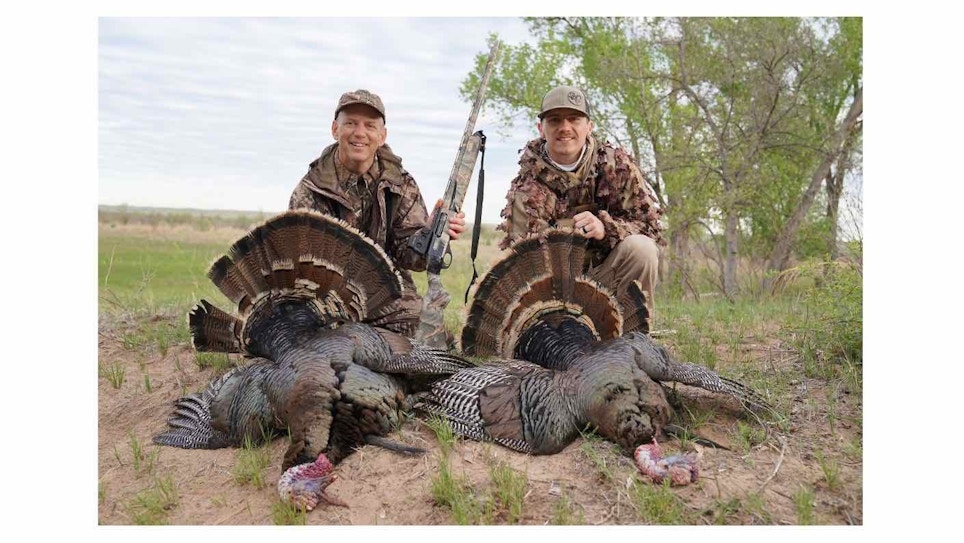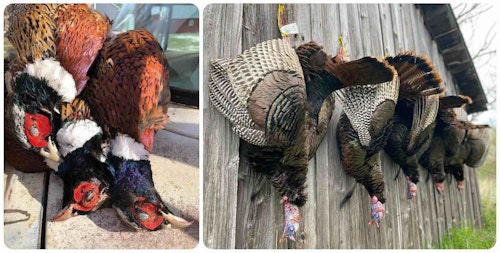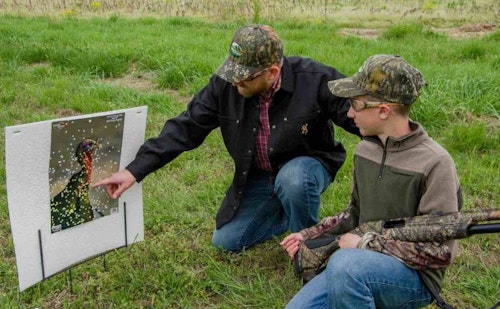
Wild turkeys are big, tough birds, but do you really need shotshells costing $12 a piece to effectively hunt them? The author (left) says “no.” He killed these two Texas toms with standard 2.75-inch No. 4 upland loads (i.e. pheasant ammo). The first was dropped at 20 yards, and the second at 35 yards as it was running away.
In the spirit of full disclosure, you should know that I have several friends who work for the biggest ammunition manufacturers on the planet. They will probably roll their eyes when they see this article, but that’s okay.
I’ve been hunting — and killing — turkeys for enough decades that I think I can offer some insight on the subject of effective turkey ammunition. Let’s be clear: I don’t consider myself an ammo expert, and my opinions are based solely on my experiences in the field shooting at living and breathing wild turkeys — not ballistic gel, plywood or sheets of metal. Keep in mind that when I say “my experiences in the field,” I’m also including many camps shared with fellow outdoor writers, where it was common for a half dozen hunters to kill a dozen birds over the period of a few days.
Fact: The latest and greatest turkey ammunition is outstanding. Period. End of story.
That said, I still think it’s important to pump the brakes a bit on whether this ammo is necessary to kill a wild turkey. What do I mean by “necessary?”
It’s all about shot selection, and specifically distance to target.
If you’re one of those shotgun gear gurus who wants to kill a turkey as far as possible, then high-tech turkey ammo is perfect for you. There is no question that heavy-for-size tungsten or even heavier tungsten super shot (tungsten-alloy) pellets carry the maximum amount of penetration power downrange. Modern turkey hunters are even using .410 shotguns loaded with this amazing ammo to drop turkeys in their tracks at 50 yards. And tungsten super shot ammo carefully matched with the best shotgun choke (through pattern testing) in a 12 gauge shotgun can effectively drop turkeys on the spot at 60 yards, perhaps even 70.
The ONLY downside to choosing tungsten super shot ammo is cost. A quick check online shows that a box (five shells) of 3.5-inch 12 gauge tungsten super shot ammo specifically designed for turkey hunting priced as high as $80. (That is not a typo.) I’ll do the math for you: That’s $16 per shot. Note: If you drop down to 3-inch loads (and approximately 1.75 ounces of tungsten super shot instead of 2.5 ounces as in the longer shell), the price drops to about $12 per shot, or $60 per box of five shells.
If you wanted to check three different choke tubes in your shotgun to examine pattern performance at 40, 50 and 60 yards, and shot twice with each choke tube at each distance (from a bench or with shooting sticks), that would be 18 shots total. And assuming you’d want at least five shells to carry with you in the field while hunting, that means you’d need 23 shells. Five boxes (25 shells) would cover it. Assuming $60 per box of five shells, the total cost for this application would be 5 x $60 = $300.
Is anyone actually pattern testing various chokes at various ranges with tungsten super shot ammo at these high prices? Maybe, but I can promise you it’s none of my regular hunting buddies.
You don’t need to load your shotgun with tungsten super shot to kill a turkey. On the opposite end of the price spectrum is using standard pheasant ammo for wild turkeys. Truth be told, I’ve killed many more gobblers with 2.75-inch No. 4 pheasant loads than I have with high-dollar turkey-specific ammo. You can buy a top-notch brand of 12 gauge, 2.75-inch upland game loads (1.25-ounces of lead) in a box of 25 for $18; that comes to $0.72 per shell.
So what does $12 per shell of tungsten super shot gain you over a standard lead load costing less than 75 cents?
Distance. But not much.
Without getting too crazy with claims of dropping long-range turkeys, it’s safe to assume that 50 yards is a reasonable maximum yardage when using tungsten super shot in a modern shotgun. Sure, you can test various chokes and various pellet sizes to extend this range to 60 yards, but will you invest the money to do so? Probably not.

With 72 cent loads, you can test patterns until you run out of paper turkey targets — or your shoulder falls off. I’ve killed many turkeys at 30 and 35 yards with standard 2.75-inch No. 4 pheasant loads, and at least a handful of gobblers at 40 yards. I’ve never lost a turkey when hunting with pheasant ammo, either.

So, the added cost for tungsten super shot realistically gains you 10 yards; a maximum of 50 yards instead of 40. In my opinion, it’s more fun shooting a gobbler at close range than far, and if I have to go home empty-handed because I couldn’t get one within 40 yards, the turkeys win the battle and I’m fine with that outcome. Only you can answer whether an extra 10 yards is worth the higher priced turkey ammo.

One final thought: Another benefit of shooting standard 2.75-inch pheasant loads at wild turkeys is recoil reduction. On a “how much pain are you in” scale from 1 to 10, with 10 being the worst, I’d say shooting a 2.75-inch pheasant load is a 4 (in my Remington 870 pump); shooting a 3-inch turkey load is an 8, and a 3.5-inch turkey load is a 9. I shoot better with less recoil, and I bet you do, too.





